run flat PONTIAC GRAND-PRIX 1993 Owners Manual
[x] Cancel search | Manufacturer: PONTIAC, Model Year: 1993, Model line: GRAND-PRIX, Model: PONTIAC GRAND-PRIX 1993Pages: 338, PDF Size: 17.3 MB
Page 4 of 338
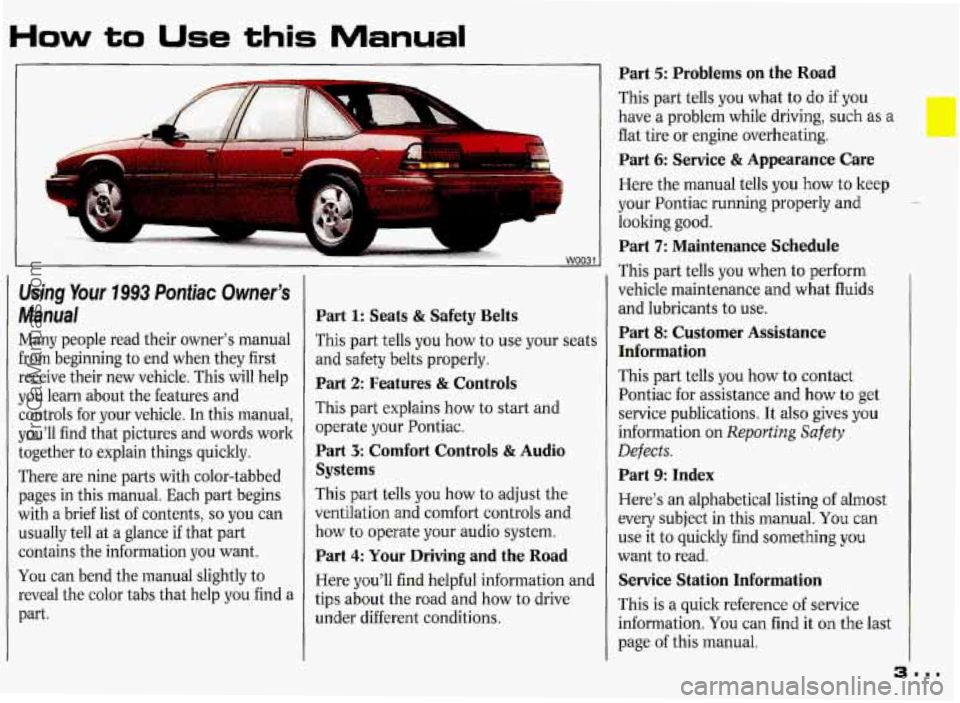
How to Use this Manual
b
Using Your 1993 Pontiac Owner’s
Manual
Many people read their owner’s manual
from beginning to end when they first
receive their new vehicle. This will help
you learn about the features and
controls for your vehicle. In this manual,
you’ll find that pictures and words work
together to explain things quicltly.
There are nine parts with color-tabbed pages in this manual. Each part begins
with a brief list of contents,
so you can
usually tell at a glance if that part
contains the information you want.
You can bend the manual slightly to
reveal the color tabs that help you find a
part.
Part 1: Seats & Safety Belts
This part tells you how to use your seat:
and safety belts properly.
Part 2: Features 8z Controls
This part explains how to start and
operate your Pontiac.
Part 3: Comfort Controls & Audio
Systems
This part tells you how to adjust the
ventilation
and comfort controls and
how to operate your audio system.
Part 4: Your Driving and the Road
Here you’ll find helpful information anc
tips about the road and how to drive
under different conditions.
Part 5: Problems on the Road
This part tells you what to do if you
have a problem while driving, such as a
flat tire or engine overheating.
Part 6: Service & Appearance Care
Here the manual tells you how to keep
your Pontiac running properly and
looking good.
Part 7: Maintenance Schedule
This part tells you when to perform
vehicle maintenance and what fluids
and lubricants to use.
Part 8: Customer Assistance
Information
This part tells you how to contact
Pontiac for assistance and how
to get
service publications. It also gives you
information on
Reporting Safety
Defects.
Part 9: Index
Here’s an alphabetical listing of almost
every subject in this manual.
You can
use it to quicltly find something
you
want to read.
Service Station Information
This is a quick reference of service
information.
You can find it on the last
page of this manual.
~~.
ProCarManuals.com
Page 51 of 338
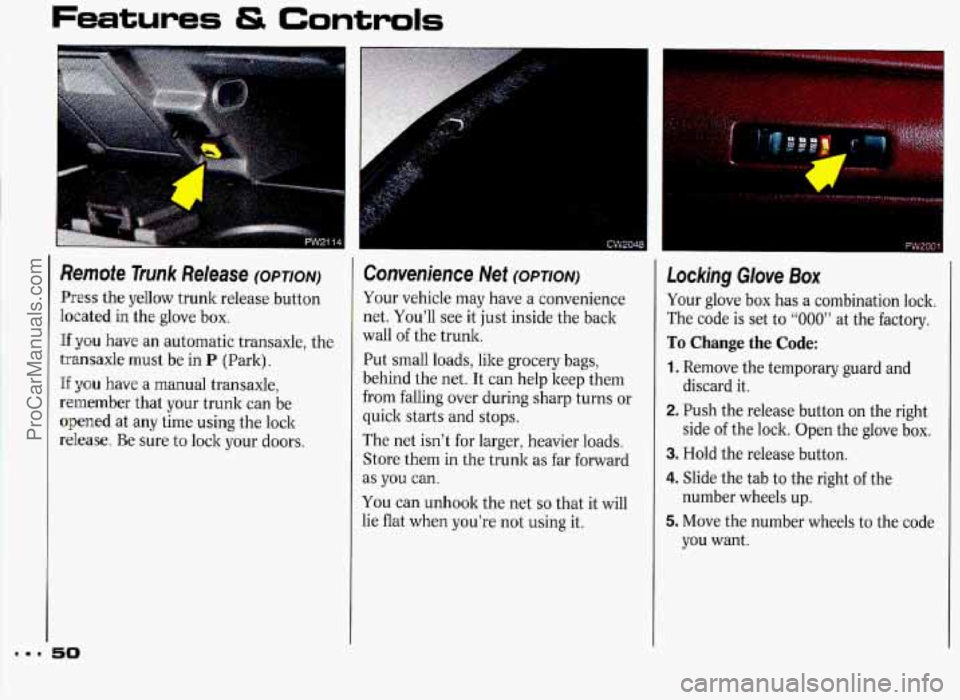
Features & Controls
Remote Trunk Release (OPTION)
Press the yellow trunk release button
heated in the glove box.
Hf you have an automatic transaxle, the
transaxle must be in
P (Park).
If y0.u have a manual transaxle,
remember that your trunk can be
opened at any time using the lock
release. Be sure to lock your doors.
50
Convenience Net (OPTION)
Your vehicle may have a convenience
net. You’ll see it just inside the back
wall
of the trunk.
Put small loads, like grocery bags,
behind the net. It can help keep them
from falling over during sharp turns or
quick starts and stops.
The net isn’t for larger, heavier loads.
Store them in the trunk as far forward
as
you can.
You can unhook the net
so that it will
lie flat when you’re not using it.
Locking Glove Box
Your glove box has a combination lock.
The code is set to
“000” at the factory.
To Change the Code:
1. Remove the temporary guard and
discard it.
2. Push the release button on the right
side
of the lock. Open the glove box.
3. Hold the release button.
4. Slide the tab to the right of the
5. Move the number wheels to the code
number wheels up.
you want.
ProCarManuals.com
Page 169 of 338
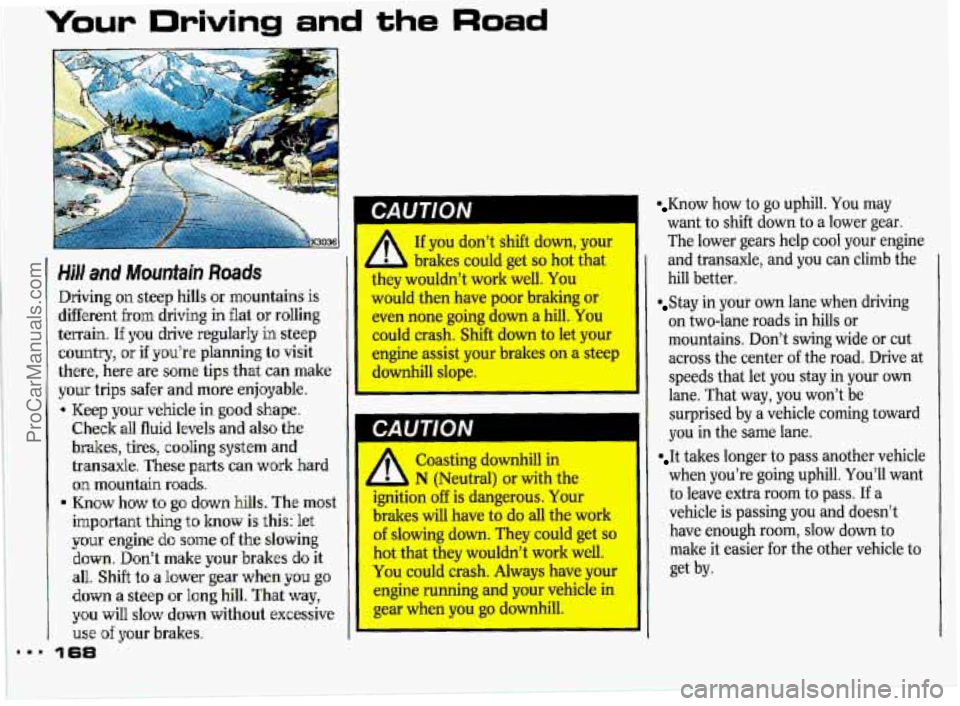
your Driving and the Road
-1
HM and Mountain Roads
Driving on steep hills or mountains is
different fiom driving in flat or rolling
terrain.
If you drive regularly in step
country, or if you’re planning to visit
there, here are some tips that can make
your trips safer and more enjoyable.
* Keep your vehicle in go’od shape.
Check all fluid levels and also the
brakes, tires, co’oling system and
transaxle. These
parts can work hard
~n mountain roads.
. K~QW how to go, down hills. The most
important thing
to how is this: let
your engine do some of the slowing
down. Don’t make your brakes do it
an.. Shift to a lower gear when YQU go
down a steep or long hill. That way,
you will slow down without excessive
use of your brakes.
168
If you don’t shift down, your
brakes could get
so hot that
they wouldn’t work well. You
would then have poor braking or
even none going down a hill.
You
could crash. Shift down to let your
engine assist your brakes on a steep
downhill slope.
I
A Coasting downhill in
- N (Neutral) or with the
* ignition off is dangerous. Your
akes will have
to do all the work
slowing down. They could get
so
riot that they wouldn’t work well.
You could crash. Always have your
Pngine running and your vehicle in
a-ar when you
go downhill.
Know how to go uphill. You may
want to shift down to a lower gear.
The lower gears help
cool your engine
and transaxle, and you can climb the
hill better.
Stay in your own lane when driving
on two-lane roads in hills or
mountains. Don’t swing wide or cut
across the center
of the road. Drive at
speeds that let you stay in your own
lane. That way, you won’t be ’ surprised by a vehicle coming toward
you in the same lane.
It takes longer to pass another vehicle
when you’re going uphill. You’ll want
to leave extra room to pass. If a
vehicle is passing you and doesn’t
have enough room, slow down to
make it easier for the other vehicle to
get by.
ProCarManuals.com
Page 207 of 338
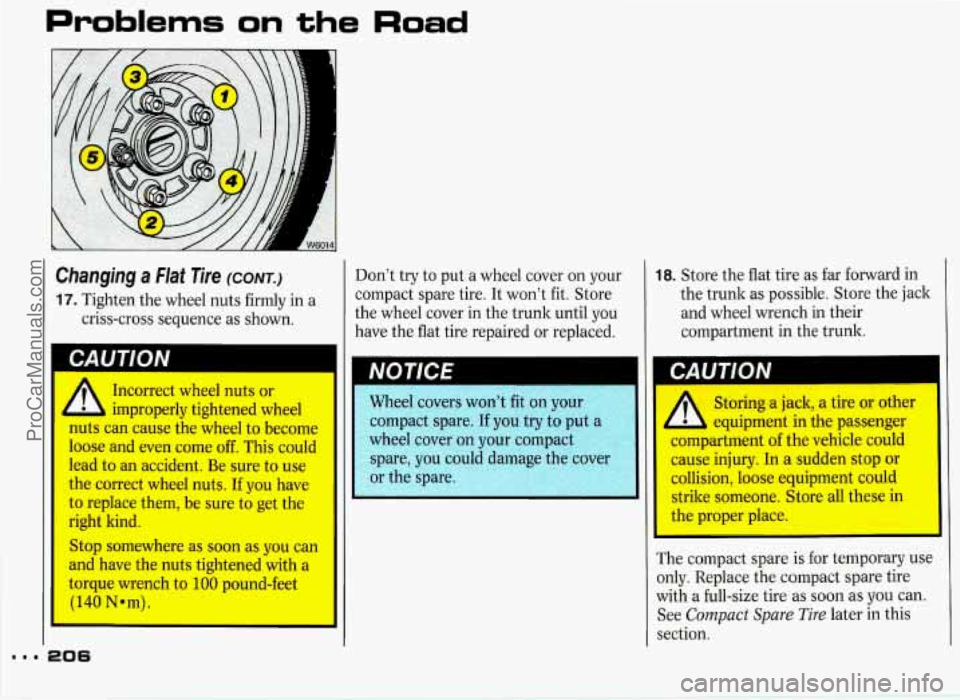
Problems on the Road
Changing a Flat Tire (CONT.)
17. Tighten the wheel nuts firmly in a
criss-cross sequence as shown.
11 CAUTION 'I
Incorrect wheel nuts or
improperly tightened wheel
nuts can cause the wheel to become
loose and even come off. This could
lead to an accident. Be sure to use
the correct wheel nuts.
If you have
to replace them, be sure to get the
right kind.
Stop somewhere as soon as you can
and have the nuts tightened with a
torque wrench to
100 pound-feet
(140 Nmm).
Don't try to put a wheel cover on your
compact spare tire.
It won't fit. Store
the wheel cover in the trunk until you
have the flat tire repaired or replaced.
I meel covers won't fit on your
compact spare. If you try to put
a
wheel cover on your compact
spare, you could damage the cover
or the spare.
I
18. Store the flat tire as far forward in
the trunk as possible. Store the jack
and wheel wrench in their
compartment in the trunk.
Storing
a jack, a tire or other
equipment in the passenger I
compartment of the vehicle could
cause injury.
In a sudden stop or I
collision, loose equipment could
strilce someone. Store all these
in
the proper place. I
The compact spare is for temporary use
only. Replace the compact spare tire
with a full-size tire as
soon as you can.
See
Compact Spare Tire later in this
section.
ProCarManuals.com
Page 253 of 338
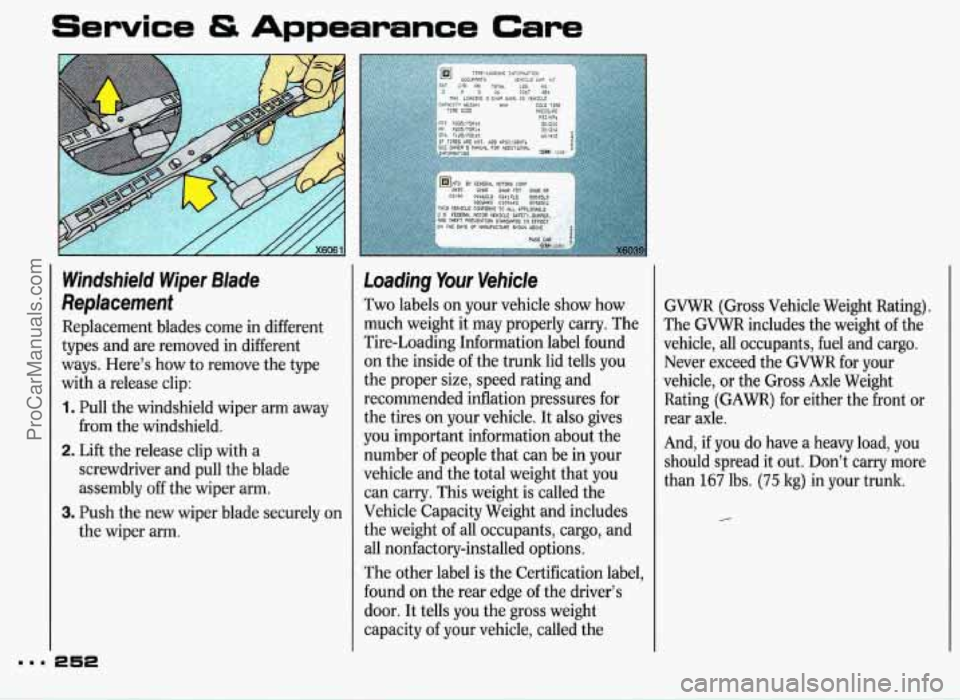
aam
Service & Appearance Care
Windshield Wiper Blade
Replacement
Replacement blades come in different
types and are removed in different
ways. Here’s how to remove the type
with
a release clip:
1. Pull the windshield wiper arm away
2. Lift the release clip with a
from the
windshield.
screwdriver and pull the blade
assembly off the wiper arm.
the wiper arm.
3. Push the new wiper blade securely on
252
Loading Your Vehicle
Two labels on your vehicle show how
much weight it may properly carry. The
Tire-Loading Information label found
on the inside of the trunk lid tells you
the proper size, speed rating and
recommended inflation pressures for
the tires on your vehicle. It also gives
you important information about the
number of people that can be in your
vehicle and the total weight that you
can carry. This weight is called the
Vehicle Capacity Weight and includes
the weight of all occupants, cargo, and
all nonfactory-installed options.
The other label is the Certification label,
found on the rear edge of the driver’s
door. It tells you the gross weight
capacity of your vehicle, called the GVWR
(Gross Vehicle Weight Rating).
The GVWR includes the weight of the
vehicle, all occupants, fuel and cargo.
Never exceed the GVWR for your
vehicle, or the Gross Axle Weight
Rating (GAWR) for either the front or
rear axle.
And,
if you do have a heavy load, you
should spread it out. Don’t carry more
than
167 lbs. (75 kg) in your trunk.
ProCarManuals.com
Page 256 of 338
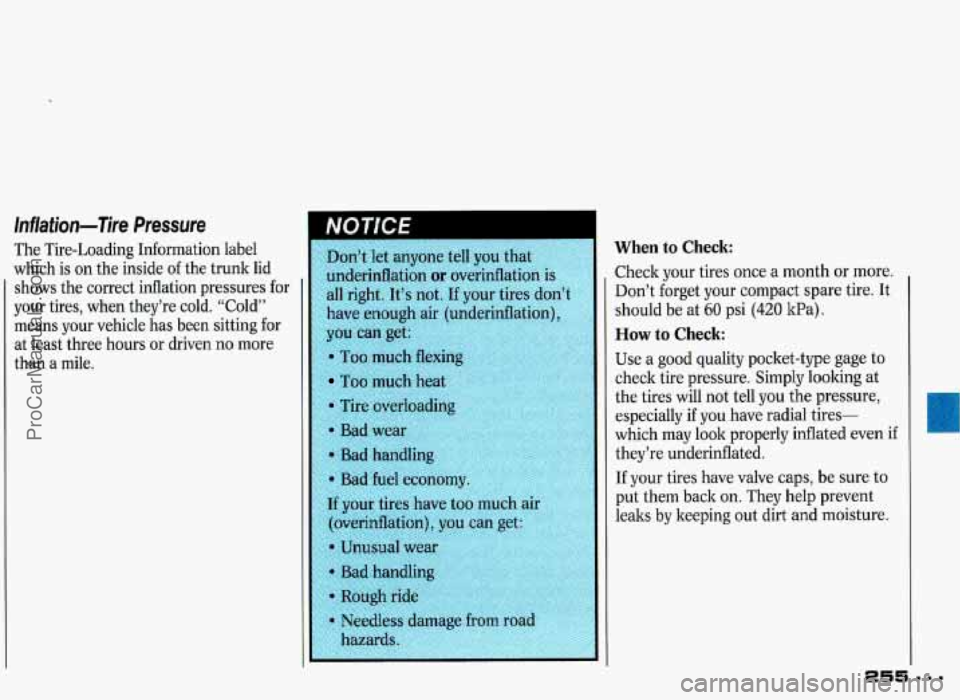
Inflation-Tire Pressure
The Tire-Loading Information label
which is on the inside of the trunk lid
shows the correct inflation pressures for
your tires, when they’re cold. “Cold”
means your vehicle has been sitting for
at least three hours or driven
no more
than a mile. Don’t let anyone
tell you th
underinflation
or overinflati
all right. It’s not.
If your tires d
have enough air (underinflation
Too much heat
If your tires have too much air
When to Check:
Check your tires once a month or more.
Don’t forget your compact spare tire. It
should be at
60 psi (420 ItPa).
How to Check:
Use a good quality pocket-type gage to
check tire pressure. Simply loolting at
the tires will not tell you the pressure,
especially if you have radial tires-
which may
look properly inflated even if
they’re underinflated.
If your tires have valve caps, be sure to
put them back on. They help prevent
leaks by keeping out dirt
and moisture.
ProCarManuals.com
Page 300 of 338
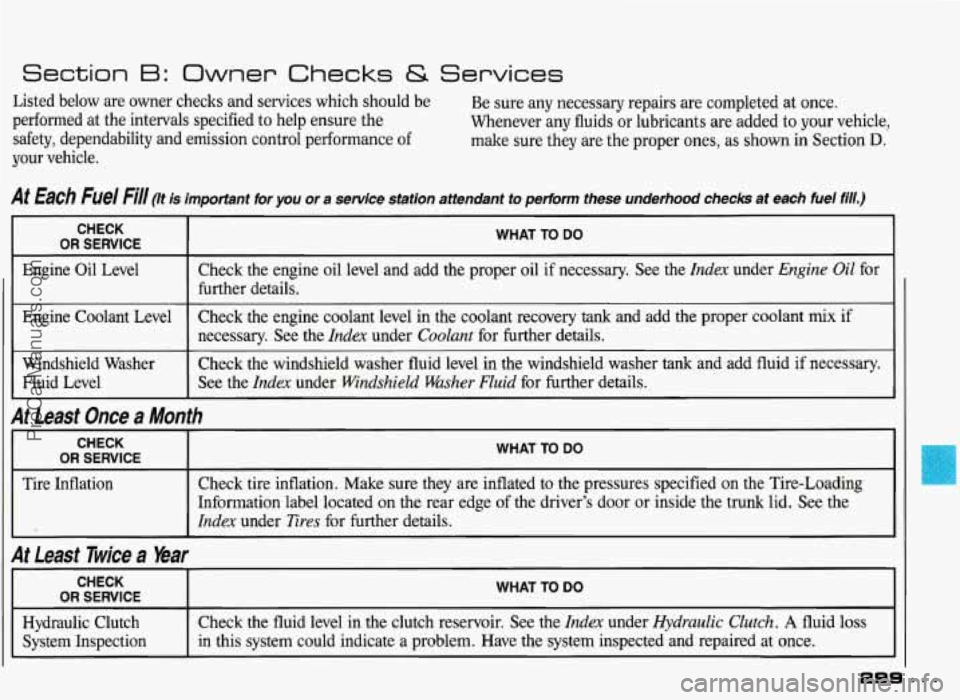
Section B: Owner Checks & Services
Listed below are owner checks and services which should be
performed at the intervals specified to help ensure the
safety, dependability and emission control performance of
your vehicle. Be
sure any necessary repairs are completed at once.
Whenever any fluids or lubricants are added
to your vehicle,
make sure they are the proper ones, as
shown in Section D.
At Each Fuel Fill (It is important for you or a sewice station attendant to perform these underhood checks at each fue\
l fill..)
CHECK
OR SERVICE WHAT TO DO
i
I Engine Oil Level
Check the engine oil level and add
the proper oil if necessary. See the Index under Engine Oil for
further details.
I
Engine Coolant Level Check the engine coolant level in the coolant recovery tank and add the proper coolant mix if
I necessary. See the Index under Coolant for further details.
Windshield Washer See the
Index under Windshield Washer Fluid for further details.
Fluid Level Check the windshield washer fluid level in
the windshield washer tank and add fluid
if necessary.
At Least Once a Month h
CHECK
OR SERVICE WHAT TO DO
Tire Inflation
Check tire inflation. Make
sure they are inflated to the pressures specified on the Tire-Loading
Information label located on the rear edge of the driver’s door or inside the trunk lid. See the
Index under Tires for further details.
At Least Twice a Year h I CHECK
OR SERVICE WHAT TO DO
Hydraulic Clutch
in this system could indicate a problem. Have the system inspected and repaired at once.
System Inspection Check the fluid level in
the clutch reservoir. See the Index under Hydraulic Clutch. A fluid loss
ProCarManuals.com
Page 329 of 338
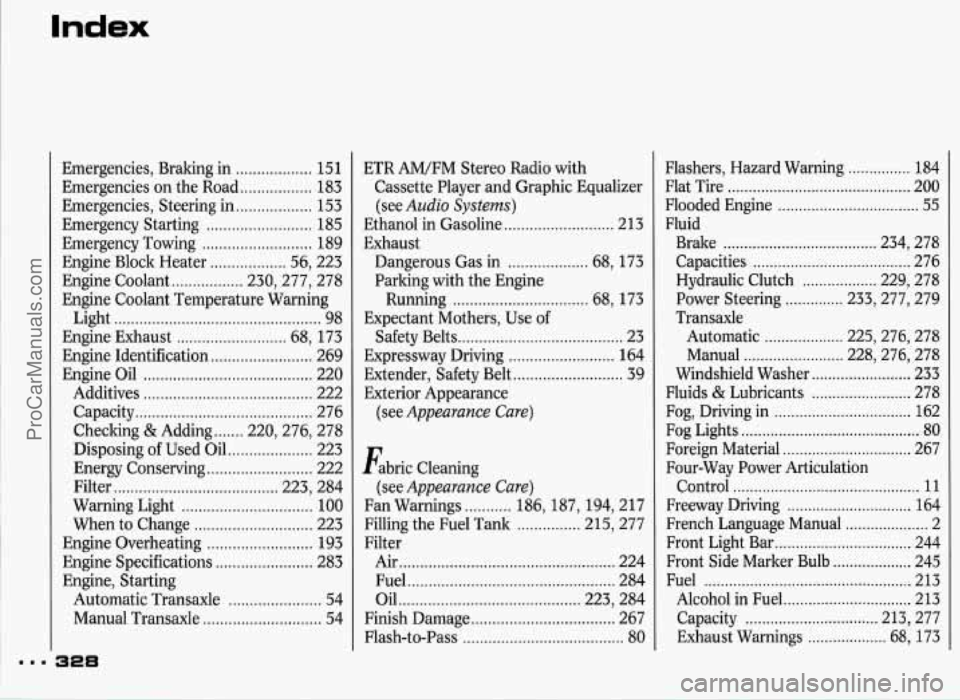
Index
Emergencies. Braking in .................. 151
Emergencies on the Road
................. 183
Emergencies. Steering in .................. 153
Emergency Starting
......................... 185
Emergency Towing
.......................... 189
Engine Block Heater .................. 56. 223
Engine Coolant
................. 230. 277. 278
Engine Coolant Temperature Warning
Light
................................................. 98
Engine Exhaust
.......................... 68, 173
Engine Identification
........................ 269
Engine Oil
........................................ 220
Additives
........................................ 222
Capacity
.......................................... 276
Checking
& Adding ....... 220, 276, 278
Disposing of Used Oil
.................... 223
Energy Conserving
......................... 222
Filter
....................................... 223, 284
Warning Light
............................... 100
When to Change ............................ 223
Engine Overheating
......................... 193
Engine Specifications ....................... 283
Engine, Starting
Automatic Transaxle
...................... 54
Manual Transaxle
............................ 54
ETR AM/FM Stereo Radio with
Cassette Player and Graphic Equalizer
(see
Audio Systems)
Ethanol in Gasoline .......................... 213
Exhaust Dangerous Gas in
................... 68. 173
Parking with the Engine
Running
................................ 68. 173
Expectant Mothers. Use of
Safety Belts
....................................... 23
Expressway Driving
......................... 164
Extender. Safety Belt
.......................... 39
Exterior Appearance
(see
Appearance Care)
Fabric Cleaning
(see
Appearance Care)
Fan Warnings ........... 186. 187. 194. 217
Filling the Fuel Tank
............... 215. 277
Filter
Air
................................................... 224
Fuel
................................................. 284
Oil
........................................... 223, 284
Finish Damage
.................................. 267
Flash-to-Pass
...................................... 80 Flashers. Hazard Warning
............... 184
Flat Tire
............................................ 200
Flooded Engine
.................................. 55
Fluid Brake
..................................... 234. 278
Capacities
...................................... 276
Hydraulic Clutch
.................. 229. 278
Power Steering
.............. 233. 277. 279
Transaxle Automatic
................... 225. 276. 278
Manual
........................ 228. 276. 278
Windshield Washer
........................ 233
Fluids
87 Lubricants ........................ 278
Fog. Driving in
................................. 162
Fog Lights
........................................... 80
Foreign Material
............................... 267
Four-Way Power Articulation
Control
............................................. 11
Freeway Driving .............................. 164
French Language Manual
.................... 2
Front Light Bar
................................. 244
Front Side Marker Bulb
................... 245
Fuel
.................................................. 213
Alcohol in Fuel
............................... 213
Capacity
................................ 213. 277
Exhaust Warnings
................... 68. 173
ProCarManuals.com